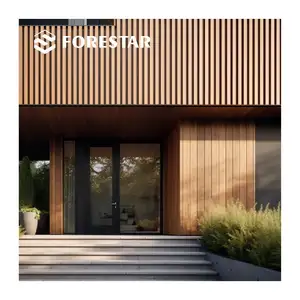

Modern WPC Exterior Outdoor Decorative Wall Cladding Panel Design Co-extrusion Panel Wooden Siding Board Building House


FORESTAR The Great Wall Siding Wall Cladding WPC Exterior Outdoor Composite Outdoor WPC Wall Cladding






















Fire safety is a paramount concern in any building, be it residential or commercial. One of the most effective ways to enhance fire safety is through the use of fireproof wall boards. These innovative products offer a robust solution to prevent the spread of fire, ensuring the safety of inhabitants and minimizing damage to property. This article delves into the world of fireproof wall boards, exploring their composition, types, benefits, installation process, maintenance, cost, and availability. We also highlight real-world case studies that underscore the critical importance of these boards in enhancing building safety.
Fireproof wall boards are a type of insulated metal panel with a 1-hour fire rating. They are available in various standard profiles and are aesthetically pleasing concealed fastener panels. Compared to a typical 1-hour rated mineral fiber panel, these 4.5" thick panels have superior R-values and weigh less, making them an excellent choice for your project.
Fireproof wall boards are made of a unique mineral fibre core, with sheet steel permanently bonded to both sides. This composition provides fire resistance for 1, 2, and 3 hours depending on the core thickness. The panels are produced in a continuous in-line method for optimum uniformity and quality. The steel top and bottom are 26 gauge pre-painted silicone-polyester finish and profiled galvanized steel facings. The core material is cut into lamella strips with perpendicular fiber orientation for additional strength, dimensional stability, and moisture resistance.
Fireproof wall boards, also known as fire-rated drywall, come in two main types: Type X and Type C. These types are thicker than standard drywall, often embedded with glass fibers, and sometimes contain additional additives to the gypsum core. Type X and Type C drywall are designed to slow the progress of fire, providing inhabitants with more time to escape. The difference between the two lies in their fire rating, thickness, and composition. They are often required by many building codes, with their rating based on assembly systems, not just the drywall alone.
Fireproof wall boards offer numerous benefits. They protect infrastructure and equipment, minimizing damage during fire incidents. They contain fires, preventing their spread to critical spaces, ensuring safety. These boards also offer design benefits, available in various finishes and colors, improving aesthetics while providing noise containment. Their versatility allows for customization to fit different business sizes and types of equipment. In essence, fireproof wall boards are a critical component in ensuring safety, minimizing fire damage, and enhancing the aesthetic appeal of your premises.
Installing fireproof wall boards is straightforward. For roof installation, place the board with the skid-resistant side up and the fire-resistant surface facing down. Ensure a 1/8˝ gap at panel ends and edges. For wall installation, panels should be installed vertically with all unsupported panel edges blocked. Nail panels 6˝ on center along supported ends and edges and 12˝ on center at intermediate supports. Fasten panels 3/8˝ from panel edges. Use appropriate nails depending on the panel thickness.
Maintaining fireproof wall boards is crucial to preserve their fire-resistant properties. This involves regular inspections for any damage that might compromise their structural integrity, such as holes or minor openings. If found, these should be sealed with firestopping products. Firestopping is a passive fire protection system that uses fire-resistant materials to cover openings, preventing smoke and flames from spreading. The materials used for repair should have the same fire resistance as the original wall board. This maintenance process helps ensure the effectiveness of your fireproof wall boards and the safety of your space.
Fireproof wall boards are available in a wide range of prices, starting from $10 to over $300, catering to various budget requirements. The cost depends on the features, materials, and size of the boards. For instance, boards with features like water resistance, mold/mildew resistance, and heat resistance may cost more. The availability of these boards is vast, with options for both interior and exterior applications. They come in different sizes, colors, and designs, providing a multitude of choices for buyers.
In the realm of fire safety, a notable case study is the perspective of a 42-year veteran firefighter. This professional has expressed concerns about the increasing use of lightweight construction materials, highlighting that the collapse of burning buildings is a leading cause of firefighter fatalities. He strongly advocates for non-combustible construction, such as fireproof wall boards, which provide greater structural integrity during a fire. This real-world insight underscores the critical importance and effectiveness of fireproof wall boards in enhancing building safety.
Fireproof wall boards are an essential component in the construction industry, offering a robust solution for enhancing fire safety. They are not only effective in containing fires and preventing their spread, but also offer design benefits and versatility. The installation process is straightforward, and with proper maintenance, these boards can retain their fire-resistant properties for a long time. Despite the cost, the safety and peace of mind they provide are invaluable. The case study of a veteran firefighter further underscores the importance of these boards in preventing building collapse during fires. In essence, fireproof wall boards are the ultimate solution for safer homes and buildings.